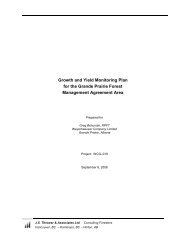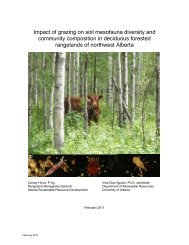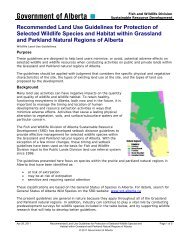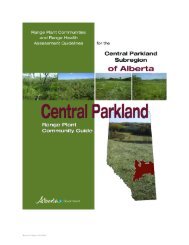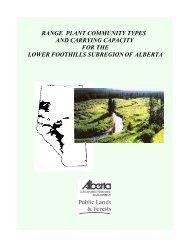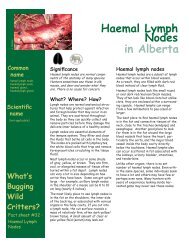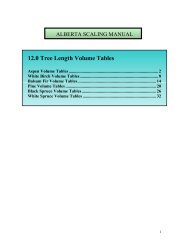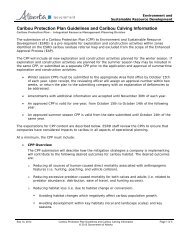Foothills Fescue Range Plant Community Guide - Sustainable ...
Foothills Fescue Range Plant Community Guide - Sustainable ...
Foothills Fescue Range Plant Community Guide - Sustainable ...
You also want an ePaper? Increase the reach of your titles
YUMPU automatically turns print PDFs into web optimized ePapers that Google loves.
The climate in the <strong>Foothills</strong> <strong>Fescue</strong> Natural Subregion is characterized by short summers<br />
with warm days and cool nights, and long cold winters, similar to the climate throughout<br />
southern Alberta. However, winter temperatures in the <strong>Foothills</strong> <strong>Fescue</strong> Natural<br />
Subregion are moderated by frequent chinook winds, which are strong westerly winds<br />
that occur most frequently in late fall and winter. The adjoining Mixed Grass Natural<br />
Subregion (Table 1), is drier, warmer in summer and has less intense Chinooks. To the<br />
west the <strong>Foothills</strong> Parkland is cooler and moister.<br />
Table 1. Key distinguishing features of the <strong>Foothills</strong> <strong>Fescue</strong> Natural Subregion<br />
compared with neighboring Natural Subregions.<br />
Natural<br />
Subregion<br />
Dominant Soils Dominant<br />
Vegetation<br />
<strong>Foothills</strong> <strong>Fescue</strong> Black Chernozem <strong>Foothills</strong> rough<br />
fescue<br />
Mixed Grass Dark Brown<br />
Chernozem<br />
<strong>Foothills</strong> Parkland Black Chernozem<br />
(Thick)<br />
Northern <strong>Fescue</strong> Dark Brown<br />
Chernozem and<br />
Dark Brown<br />
Solonetz<br />
Wheatgrasses<br />
and spear grasses<br />
<strong>Foothills</strong> rough<br />
fescue, shrubs<br />
and aspen forest<br />
Plains rough<br />
fescue and<br />
Porcupine grass<br />
Central Parkland Black Chernozem Plains rough<br />
fescue, shrubs<br />
and aspen forest<br />
General Climate<br />
Compared to <strong>Foothills</strong><br />
<strong>Fescue</strong><br />
winter climate moderated by<br />
Chinooks, high frequency of<br />
snowfall in late winter and<br />
early spring (Achuff 1994)<br />
drier, warmer summers, less<br />
intense Chinooks<br />
cooler and moister<br />
colder, more continental, drier<br />
and fewer Chinooks<br />
colder with significantly fewer<br />
Chinooks<br />
Mean annual precipitation in the <strong>Foothills</strong> <strong>Fescue</strong> ranges from about 397 mm at Del<br />
Bonita to 589 mm at Pincher Creek. The Cardston Plain receives more precipitation than<br />
the other three Ecodistricts (Table 2) due to its proximity to the Rocky Mountains and the<br />
higher frequency of snowstorms in late winter and early spring. The <strong>Foothills</strong> <strong>Fescue</strong><br />
overall receives more snowfall in late winter and early spring than does the Northern<br />
<strong>Fescue</strong> Subregion (SCA4) (Achuff 1994).<br />
Mean daily temperature in the <strong>Foothills</strong> <strong>Fescue</strong> ranges from 3.8 o C at Whiskey Gap and<br />
High River, to 5.4 o C at Cardston (Table 2). Cardston is highly influenced by chinooks, in<br />
7



